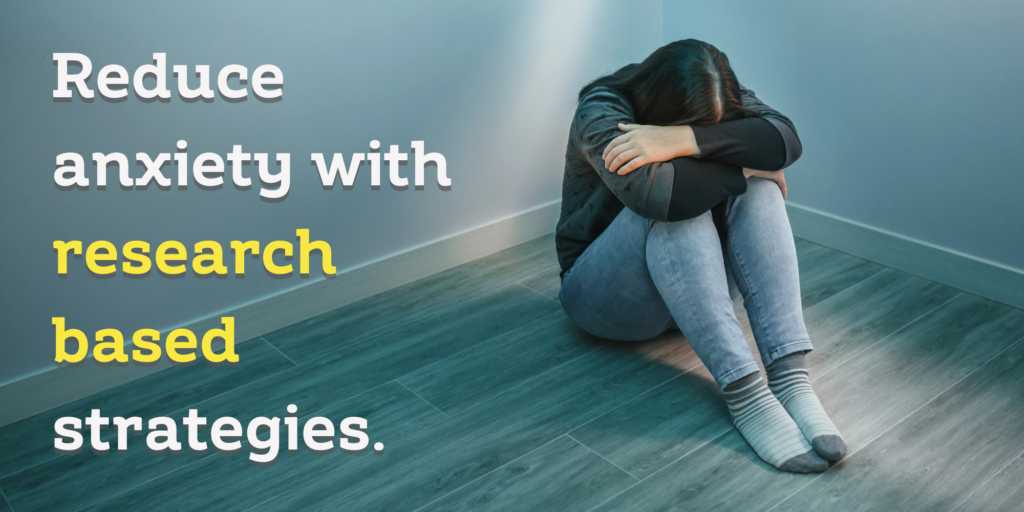It is difficult to deal with a teen that has anxiety. Often you might feel that nothing you can say has an impact on their levels of stress. You are not alone as more and more parents are struggling with the same issue. Teen anxiety is at an all-time high. Whether it’s pressure from school, social media, friendships, or uncertainty about the future, many teens struggle with overwhelming stress. As a parent this can be heartbreaking to witness.
But don’t give up, you can help your teen. Over the past decades there has been a lot of research done on what causes anxiety and how we can overcome it. Having read a lot on the subject I have taken my key learnings and put them into this series of blog posts. In these blog posts there are science-backed strategies you can use to help your teen navigate anxiety and build resilience. l offer clear and actionable steps for you and your teen to take and I also explain the reason or the logic why it works.
The first one will focus on the mental tools. How anxiety can be reduced by tapping into the power of our minds to reframe or what our inner voice is saying.
Keep reading to learn more about 5 expert-driven techniques, based on research from leading psychologists, neuroscientists, and behavioral experts. And how they can help you get your teen out of this slump of stress, fear or negativity.
1. The Power of Mental Time Travel
Backed by: Myra Shankar (Behavioral Scientist)
Why It Works:
Anxiety makes us feel trapped in the present moment, as if our fears will last forever. But our brains learn from experience—reminding your teen that they’ve faced anxiety before and came out the other side can help them see that this, too, shall pass. Recognizing that emotions change over time allows them to step back and view their worries more objectively, rather than being completely consumed by them. This shift in perspective helps weaken anxiety’s grip, making it feel more manageable.
Try This With Your Teen:
Ask: “Can you remember a time when you were really anxious, think about how you felt in the moment and how you feel about that thing now?” or reference a particular moment when you remember your child being overwhelmed with anxiety.
Maybe it was a big test they were worried about, but once they started, it wasn’t so bad. Or maybe they were nervous about making new friends, but now they love their new group.
The Science Behind It:
Research shows that when we recall past resilience, it reduces present anxiety and strengthens emotional regulation (Shankar, 2023).
2. The Distancing Technique: Thinking Like an Outsider
Backed by: Ethan Kross (Psychologist, author of Chatter)
Why It Works:
When we’re anxious, we become trapped in our own emotions. But viewing a problem as if it belongs to someone else makes it less overwhelming and more manageable. Looking at a problem from the outside in, makes us better problem solvers.
Try This With Your Teen:
Ask: “If your best friend had this problem, what advice would you give them?”
For example, if your teen is stressed about an upcoming presentation, they might say, “I’d tell my friend that they’ve practiced a lot and they’ll do great!” This helps them access their own wisdom and confidence.
The Science Behind It:
Studies show that self-distancing reduces emotional intensity and improves decision-making under stress (Kross, 2021).
3. The Power of Writing: Journaling Anxiety Away
Backed by: Dr. James Pennebaker (Psychologist, University of Texas)
Why It Works:
Anxiety is like a tangled ball of thoughts. Writing things down helps untangle them. It externalizes worries, so they feel less overwhelming. By spending time reflecting on paper, teens can explore their thoughts and feelings, which can lead to a deeper understanding of themselves and their situation.
It is said that spending 15 – 25 minutes writing about our negative experiences can improve welling being in a substantial way .
Try This With Your Teen:
Encourage them to write for 10 -20 minutes about what’s making them anxious—no editing, no overthinking.
Ask: “Imagine you are the main character in a movie and a voice over is narrating your thoughts?” This metaphor helps detach from negative thoughts instead of feeling consumed by them.
The Science Behind It:
Expressive writing lowers stress, improves mood, and increases emotional clarity (Pennebaker, 2018).
4. Create a Cognitive Board of Friends
Backed by: Ethan Kross (Psychologist, University of Michigan)
Why It Works:
We all know how good it feels to vent to a friend. But have you ever noticed that after venting, your worries feel even more justified? That’s because when we vent, our friends often confirm our fears:
“Yeah, that sounds awful! No wonder you’re stressed.”
But what if your teen had a friend group that helped them challenge their thoughts?
Try This With Your Teen:
Encourage them to build a “cognitive board of friends”—two or three people who won’t just agree with their fears, but will ask questions, offer alternative perspectives, and gently challenge their thinking.
Ask: “Before you talk to your friend about this, tell them that you don’t want them to agree with you, instead you need to ask them to challenge your thoughts?”
The Science Behind It:
Cognitive reframing—or seeing problems from different perspectives—reduces anxiety and helps develop a more balanced way of thinking (Kross, 2021).
5. Reframing Fear as Excitement
Backed by: Harvard University (Alison Wood Brooks, 2014)
Why It Works:
Anxiety and excitement feel physically the same—racing heart, sweaty palms. But when we relabel fear as excitement, we feel more in control.
Try This With Your Teen:
Before a nerve-wracking event, have them say out loud: “I’m excited!”
The Science Behind It:
Harvard research shows this simple reframing boosts confidence and performance under stress (Brooks, 2014).
Final Thoughts: Helping Your Teen Break Free from Anxiety
By guiding your teen to reframe anxiety, you’re equipping them with powerful mental tools that can reshape how they see challenges. Anxiety doesn’t have to control their life—by looking at past successes, thinking like an outsider, writing things down, surrounding themselves with the right voices, and transforming fear into excitement, they can take back control.
These strategies are backed by science, but they only work if they are practiced consistently. Encourage your teen to try them in small moments of stress, and over time, they’ll build resilience that lasts a lifetime.
But we’re not stopping here! In Part 2, I’ll be sharing real-world actions your teen can take to manage anxiety beyond mindset shifts—practical, science-backed steps that will help them feel calmer and more in control.
Would you find a free, downloadable eBook helpful? I’m considering creating a comprehensive guide based on all my research, so parents have an easy resource to refer back to. If that sounds useful, let me know in the comments!







